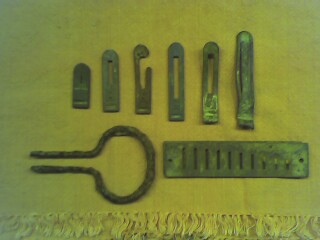Solving a relic mystery?
 Our trip to Gettysburg last weekend rekindled one of my old passions. You can't grow up in the South without absorbing a lot of Civil War mythology. It didn't matter that the South lost, it was the nobility (and perhaps the futility) of their struggle that captured our imaginations. A few years ago, back in Tennessee, a boyhood fascination grew into a mid-life obsession as I became an avid collector of Civil War relics.
Our trip to Gettysburg last weekend rekindled one of my old passions. You can't grow up in the South without absorbing a lot of Civil War mythology. It didn't matter that the South lost, it was the nobility (and perhaps the futility) of their struggle that captured our imaginations. A few years ago, back in Tennessee, a boyhood fascination grew into a mid-life obsession as I became an avid collector of Civil War relics.My buddy Curtis and I located some of the 1863-64 winter encampments of the Confederate Army of Northern Virginia near where we grew up. The Division, commanded by General James Longstreet and still over 30,000 strong, had moved south into Tennessee after their loss at Gettysburg. Almost 150 years later, our metal detectors turned up the things they left behind: military items such as bullets, buttons, a handful of rare and valuable belt plates, and those routine items of everyday soldering.
Being a musician, my very favorite finds were musical instruments. Curt and I probably found 50 harmonicas, a dozen jews harps, and a handful of another curious musical items that we still haven't positively identified. At first, we thought these small brass bars, pictured in the top of the photo above, might be a rifle site of some sort because we dug one up between a Confederate artilleryman's button and some Spencer rifle shell casings. After we found more of various lengths scattered around the camp, each marked with a letter that corresponds with a note in the musical scale, it was obvious they were parts of an instrument. We suspected they might be reeds to a wind instrument of some sort, but we've never been quite sure.

At the Gettysburg Visitor Center, next to the "Drinking" display, was an exhibit of Civil War musical instruments. I was instantly drawn to a paper accordian in the display case, probably sold by Civil War sutlers and easily available to the troops. The accordian was fitted with small brass reeds that look very similar to the ones we found in Longsteet's camps. There are some differences, including the attachment holes in the one pictured, but otherwise they look like they are the same size and shape as our relics. Curtis isn't sure, but I think we might have solved the mystery!
What do you think? -S




2 Comments:
instyler, soccer shoes, nike huarache, converse, babyliss, nfl jerseys, nike air max, vans, p90x workout, ralph lauren, valentino shoes, gucci, nike roshe, iphone cases, abercrombie and fitch, lululemon, celine handbags, chi flat iron, herve leger, louboutin, mont blanc, beats by dre, asics running shoes, longchamp, lancel, hollister, ferragamo shoes, ghd, converse outlet, vans shoes, north face outlet, baseball bats, nike air max, north face outlet, wedding dresses, timberland boots, mac cosmetics, bottega veneta, ray ban, new balance, soccer jerseys, hollister, oakley, nike trainers, birkin bag, insanity workout, hollister, jimmy choo shoes, reebok shoes, mcm handbags
ugg pas cher, doudoune canada goose, canada goose outlet, pandora charms, swarovski crystal, canada goose, ugg boots uk, moncler, bottes ugg, wedding dresses, juicy couture outlet, sac louis vuitton pas cher, moncler, toms shoes, louis vuitton, replica watches, thomas sabo, coach outlet, canada goose, moncler, supra shoes, marc jacobs, montre pas cher, moncler, canada goose, hollister, swarovski, moncler outlet, moncler, juicy couture outlet, moncler, canada goose, karen millen, louis vuitton, canada goose outlet, ugg,uggs,uggs canada, louis vuitton, pandora jewelry, canada goose uk, pandora charms, pandora jewelry, louis vuitton, ugg,ugg australia,ugg italia, links of london, moncler
Post a Comment
<< Home